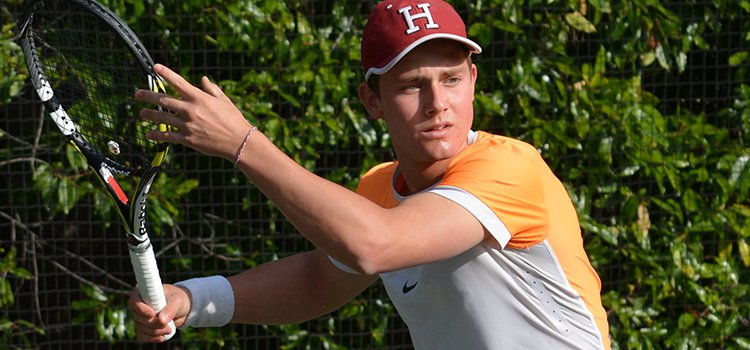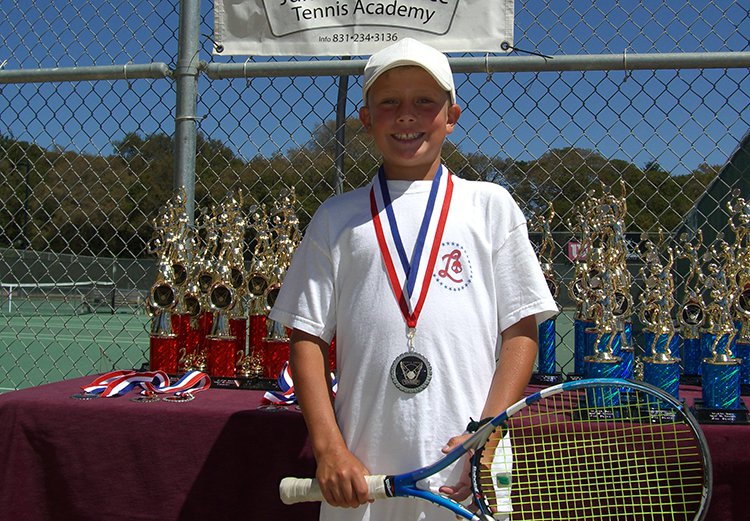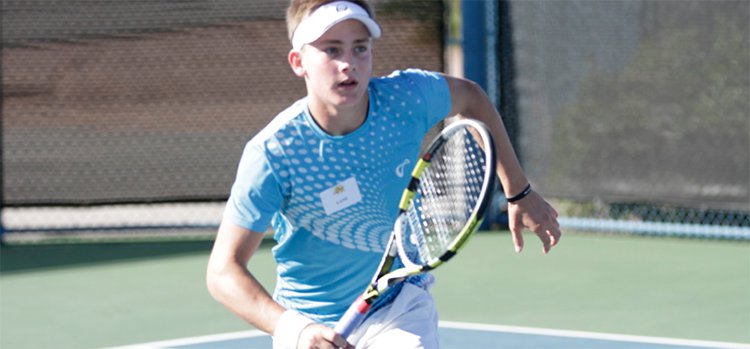Competitive tennis: One family’s journey from summer tennis camps, clinics, and private instruction to competing for an Ivy League school.
By Laura Quaglio

When Lane L. was age 4, he – like plenty of other kids his age – attended his first tennis clinic with a few buddies from his preschool. Today, as a high-school senior, Lane is ranked nationally in the top 40 players in his age group by the United States Tennis Association (USTA), and he recently was ranked in the top 250 junior players in the world by the International Tennis Federation. In fall of 2016, he will be taking those skills to Harvard, where he was recruited to play on their highly competitive Division 1 tennis team.
What does it take to rise from “summer tennis camp kid” to “nationally and internationally ranked player”? Could your child have what it takes? And is your family willing and able to invest the time and money needed to reach this level of play? To parents who haven’t participated in the elite level of a sport, these questions can be nearly impossible to answer without additional information. That’s why ActivityHero recently talked to Lane’s mom, Darcy, to find out more about what goes on “off the court” in competitive tennis from preschool through high school. Darcy shares her insights – and Lane’s winning training program – here.
Having a Ball with Buddies
Considering his family history, it’s no surprise that Lane was holding a racket before he entered kindergarten. Lane’s grandfather was an internationally ranked pro tennis player, as was Lane’s dad, Mark, who also played tennis for Harvard. So it was natural for the family to enroll Lane in a tennis clinic early on. Though there is increasing pressure to push kids to be coached privately earlier and earlier, Darcy and Mark agree that private lessons before age 6 aren’t a good way to spark a child’s interest in a sport. “Clinics instill that sense of joy and excitement,” she says. “To do a private lesson with a 27-year-old when you’re 5 or 6 years old is not fun. At that age they want to be running around with their buddies.” That is just what a tennis clinic or summer camp session provides.
See a List of Tennis Camps & Clinics Near You >>
For the next few years, the family limited Lane’s tennis training to experiences at summer camps and clinics, as well as court time with his Dad. Though Lane tried a few other sports in his elementary-school years, “tennis was always our anchor,” says Darcy. “I think that many parents who played Division 1 sports in college want their kids to play Division 1 sports, too,” says Darcy. “They want their kids to have a similar experience.”
 Getting Noticed on the Court
Getting Noticed on the Court
By the time Lane was in grade school, coaches were commenting on his special affinity for the sport. “At age 7 or 8, you start seeing kids’ skills emerge more,” she says. “Though they are still young, they start having the perception, ‘I’m good at this and not at this,’” she says. “Even at that age, there’s a difference between kids who are running around on the court and those who have natural skills.”
The first week that Lane’s family moved to Menlo Park,Calif., Lane’s parents enrolled him in a local fall recreational tennis clinic. The owner of the rec clinic was happy to work with Lane, but he recognized after the first session that the clinic wasn’t advanced enough for the boy. “He said to me, ‘Your kid really should be up at Alpine Hills [a well-regarded tennis club] getting instruction,’” says Darcy. The advice came as a pleasant surprise, and they heeded it.
Until then, Darcy and Mark weren’t sure whether Lane’s abilities were unique or not, since many parents see their kids as amazing or special. “If you are the only one who thinks your kid can excel at a sport, then maybe or maybe not,” says Darcy today. A better indicator, she adds, is when other people (especially coaches) have told you that your child shows promise. “Most people coach the sport because they love the sport. When they see natural skills, they will tell you because they want to see kids excel,” she says. (If you’ve heard a similar message from one of your kid’s coaches, let ActivityHero help you explore the options for additional or more personalized instruction in your local area.)
Getting Noticed in School
By sixth grade, Lane was becoming known by peers as “the tennis kid,” says his mom. “At that age, you want to be that kid,” she says. So Lane made the decision to become an even better player.
By seventh grade, Lane was attending both tennis clinics and private lessons from a former Stanford player. At this point, the family began talking extensively with other local parents whose older kids were ranked in the section and nationally. “Most parents are so happy to share their knowledge,” says Darcy. Talking to them, she says, is the best way to gain some insights into the sport that you hadn’t considered.
For instance, she explains, more “individual” sports like tennis don’t offer much opportunity for carpooling. That’s because kids who attend a tennis tournament will play until they lose, so they might be there for one match … or for a whole day. Or your kid’s match may start several hours later than their friend’s, so they may be at the same tournament but not at the same time. It’s far easier to organize carpools for soccer players, who attend games and practices together and for the same timespan.
Also, tennis doesn’t offer the social interaction or growth that a team sport supplies, says Darcy. Even if kids are on their high school tennis team, their teammates are also their competitors. So they don’t develop the same type of bond as do members of football, basketball, soccer, lacrosse, and other teams.
“You’ve got to be willing to pick up the phone and really do your homework when entering into a new sport, or you won’t be going down the most efficient path,” says Darcy. One caveat: It’s important to remember that what another family or kid experienced may not be what you would see if your child attended a camp or clinic. Meshing well with a coach depends a lot of personality, so one kid can dislike an instructor who might truly motivate your child.
Ramping Up Practice Time
Starting in middle school, Lane practiced tennis two days a week and competed in USTA tournaments on the weekends. By seventh or eighth grade, he was doing “pretty intensive tournament classes” three days a week for two-and-a-half hours at a time. He also spent some time learning about sports nutrition and overall fitness and conditioning. His homework and other activities began to revolve around tennis, and although many of his friends were playing flag football in the fall, Lane opted out of it in favor of focusing on developing his skills on the court. (Today, though, both Lane and Darcy say they wished he’d participated in a team sport as well as tennis, if only at the rec level, because of the social interaction and the benefits of extra conditioning that it would have provided.)
By high school, Lane was practicing five days a week, year-round, since tennis has no “off season.” But, explains Darcy, they knew that the tournaments were the key to Lane’s future success. “If you want to get recruited for tennis, it’s all about the tournaments,” she says. “Being on your high school tennis team has zero impact on being recruited to play tennis in college. It’s all about how you rank in the USTA.”

Courting College Tennis Coaches
In many ways, high school is a crossroads, particularly for young athletes, says Darcy. “High school is one of those frontiers where you decide whether you want to go to college for your sport or just have a lot of fun and enjoy your high school experience,” says Darcy. Though she thinks most kids choose the latter, Lane opted to further increase his commitment to tennis during his senior year. Having already been recruited by Harvard, his new goal was to compete in International Tennis Federation tournaments and earn the opportunity to play in a junior grand slam.
To achieve this goal, Lane traveled internationally for six months, enrolling in online high-school courses during the fall of 2015, the first semester of his senior year. Fortunately, the family’s financial circumstance allowed for hiring a private coach to accompany Lane on his trips to Switzerland, France, Mexico, and other countries. He ultimately achieved his dream and competed in the Australian Junior Open in January, in which he ranked in the top 250 junior players in the world. “We have three other kids, and you have to have an adult travel with your child,” says Darcy. “You don’t have to compete internationally to get recruited for college,” she adds. “That was part of his dream, and we are lucky enough to be able to support that.”
Considering the Costs
Expenses, adds Darcy, are also a big consideration when it comes to elite sports: They are typically very costly. In fact, the headline of one 2014 article says as much: “Want Your Kid to Win the Open? Spend $400,000 on Lessons.” “I had no idea how much money we’d be spending on equipment alone,” says Darcy. Lane wears through a pair of tennis shoes in two weeks at a cost of about $100 per pair. He also carries eight rackets in his bag, since he typically breaks at least one racket string per match, at a replacement cost of $25 per string. As a result, Lane’s family has invested in their own tennis stringing machine. (Nice ones can be priced between 4,000 and $12,000, and a roll of 12 rackets’ worth of string costs about $250.) A corporate sponsorship helps offset some of the equipment costs for Lane, but certainly not significantly enough to make the sport an inexpensive activity.
Clinics, classes, and private instruction also add up to hundreds or thousands of dollars each year, with costs varying depending on location, duration, and the level of experience of the coaches. ActivityHero can help families find tennis programs that are best suited to their child’s needs, level of interest, and geographic location. The website can also help parents compare costs, cancellation fees, instructor experience, and more.
Tournaments each require an entry fee and often travel expenses, too, which can include a hotel stay and airfare, as well as meals and other incidentals. And if you’re going into an elite sport hoping that the costs may one day be offset by a college scholarship, that’s not a given. “You can’t go into a sport thinking, ‘My kid is going to get a scholarship.’ If it happens, it’s awesome, but it’s not a realistic expectation,” says Darcy. “Some schools may not offer athletic scholarships at all [the Ivy League does not], and others may only offer them to a few students – or they may offer only a partial scholarship. It’s very rare to receive a full scholarship for tennis.” Even recruitment (with or without a scholarship) can be iffy. “This year there are around 15 out of 150 kids in Menlo School’s senior class who were recruited by a college for their sport,” she estimates.
Thinking Past the End of His Racket
Lane is excited to get on the court as a Harvard player in a few months, but right now he’s focused on recovering from an injury – another factor in elite sports that parents shouldn’t ignore. “They ask you that question in Ivy League interviews,” says Darcy. “If you get hurt the first day of college, what are you going to do here if your sport is your whole identity?” Colleges try to get the kids away from thinking that they are just there to play their sport, so it’s not a bad idea to talk with your child about this throughout their years of play.
Bottom line, says Darcy, if your kids are still little, try to live in the moment and enjoy life one clinic, lesson, or match at a time. “Don’t say, ‘I want this kid to play this sport in college,’” she advises. There are simply too many variables that will occur over the ensuing years that can change that initial plan. Her third son, who recently dropped tennis to take up lacrosse in middle school, is proof enough of that. “Now I’m just having my daughter play everything,” says Darcy of her fourth child, who is 10 years old. Though Darcy and her husband would love for each of their kids to play the “family sport” in some capacity, they ultimately want their kids to be happy. And that, she says, is the best way to gauge how long they should stay in a sport and how far they should try to take it.
 Taking Your Child’s Sport to the Next Level
Taking Your Child’s Sport to the Next Level
Darcy says that summer is the best time to explore kids’ new interests, build skills for their favorite sport, and check out different and sometimes more challenging programs. To see what your local area (and other areas in the country) have to offer, go to ActivityHero and enter your child’s interests to receive a customized list of providers that might be a good fit for you.
 Getting Noticed on the Court
Getting Noticed on the Court Taking Your Child’s Sport to the Next Level
Taking Your Child’s Sport to the Next Level